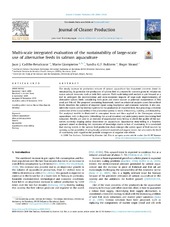| dc.contributor.author | Strand, Roger | |
| dc.contributor.author | Cadillo-Benalcazar, Juan J. | |
| dc.contributor.author | Giampietro, Mario | |
| dc.contributor.author | Bukkens, Sandra G. F. | |
| dc.date.accessioned | 2020-08-10T09:39:47Z | |
| dc.date.available | 2020-08-10T09:39:47Z | |
| dc.date.issued | 2020 | |
| dc.Published | Strand R, Cadillo-Benalcazar, Giampietro M, Bukkens. Multi-scale integrated evaluation of the sustainability of large-scale use of alternative feeds in salmon aquaculture. Journal of Cleaner Production. 2020;248:119210 | eng |
| dc.identifier.issn | 0959-6526 | |
| dc.identifier.issn | 1879-1786 | |
| dc.identifier.uri | https://hdl.handle.net/1956/23608 | |
| dc.description.abstract | The steady increase in production volume of salmon aquaculture has sharpened concerns about its sustainability. In particular the production of salmon feed is a reason for concern given its reliance on scarce natural resources, such as wild fish captures. Multi-scale integrated analysis is put forward as a tool to anticipate the environmental and socio-economic impacts of large-scale implementation of alternative salmon feeds, considering both plant and insect sources as potential replacements of fish meal and fish oil. The proposed accounting framework, based on relational analysis across hierarchical levels, describes the patterns of required inputs using biophysical and economic variables. It also considers the inputs used by external systems for the production of imported feed, thus providing a coherent assessment of the sustainability of the production system in terms of feasibility, viability, and desirability. The analytical tool-kit is illustrated in conceptual terms and then applied to the Norwegian salmon aquaculture, both in diagnostic (describing the actual situation) and anticipatory mode (examining feed scenarios). Results are used in an exercise of quantitative story-telling to check the quality of the narratives currently shaping policy discussions on aquaculture. Quantitative story-telling is a heuristic approach aimed at checking the robustness of knowledge claims in face of uncertainty. It is concluded that rearing insects in the salmon feed production chain enlarges the option space of feed sources by opening up the possibility of using locally-produced seaweed and organic waste, but also raises the level of uncertainty with regard to the possible insurgence of negative side effects. | en_US |
| dc.language.iso | eng | eng |
| dc.publisher | Elsevier | eng |
| dc.rights | Attribution CC BY | eng |
| dc.rights.uri | http://creativecommons.org/licenses/by/4.0 | eng |
| dc.title | Multi-scale integrated evaluation of the sustainability of large-scale use of alternative feeds in salmon aquaculture | eng |
| dc.type | Journal article | eng |
| dc.type | Peer reviewed | eng |
| dc.date.updated | 2020-01-31T09:34:28Z | |
| dc.description.version | publishedVersion | |
| dc.rights.holder | Copyright 2019 The Author(s) | eng |
| dc.identifier.doi | https://doi.org/10.1016/j.jclepro.2019.119210 | |
| dc.identifier.cristin | 1787737 | |
| dc.source.journal | Journal of Cleaner Production | |

